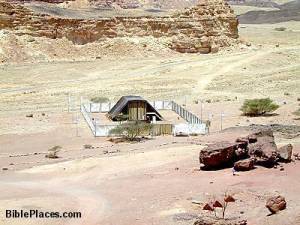I did an internet search the other day looking for artist’s conceptions of the ark of the covenant so I could add one to this blog. I found a few, but none of them really seemed right to me. Their cherubim looked too much like human beings with wings attached to their shoulders. Ezekiel describes cherubim as man-shaped but with four faces and four wings each! Scary looking, if you ask me. None of the images I found on the internet looked much like that.
While I was looking for that, I kept coming across other references to the ark, especially people’s ideas of where it might be today. And of course, the Indiana Jones movie about searching for the ark…
It seems that lots of people have searched and some folks claim to know where it is. Ethiopia is one place. Beneath the remnants of the Temple in Jerusalem is another.
Then there’s all the fantastic hype about what a treasure-trove it would be, if somebody actually found it and controlled it! What kind of power would it wield?! And what would that kind of power be worth?!
Atomic energy! Uranium! Black-hole, worm-hole, doorway to some other universe, creative power!
Huh? Hogwash.
The only power in that metal-covered wood box-shaped chair resided in its resident. Almighty God may have “sat” on it whenever he came in visible form to visit Moses and dictate laws, ordinances, rules and regulations, as well as to accept worship from Moses, Aaron, Joshua, and whoever else showed up to worship in the prescribed manner.
In any case, he spoke to Moses from there, and the cloud and fire the people saw emanated from there, whenever God was in the building.
When God left the building, the power left the building.
The ark wasn’t an atomic-energy, radioactive good luck charm then and it wouldn’t be one today. It was a chair and a container, and because God was the only legitimate user of that chair, it was holy to God. Set apart. Dedicated. For his use only.
Sure, the fellow Uzzah (II Sam. 6) who tried to keep it from falling off the cart died for his troubles. So, was he zapped by some form of electricity, as some claim? Or did his unclean, unsanctified, unprepared, unbelieving and disobedient state earn him the death penalty?
If you read Numbers chapter 4 about the proper way to move the ark whenever God was ready to break camp, you’ll see in v. 15, “…they shall not touch any holy thing, lest they die.” The ark (and everything else in the Tabernacle) had to be carefully packed up for the move. The ark had to be wrapped up, first in its covering veil, then in the heavy tent roofing materials, then finally in a blue cloth. And could only then be carried by specific men, the sons of Kohath, who himself was one of Levi’s sons.
If it had been packaged up like God instructed, the ark would have been completely covered up and Uzzah’s hands couldn’t have reached it to touch it. Its magical nuclear power, or whatever people seem to think it had, didn’t kill Uzzah, disobedience killed him.
If anybody ever does really find the ark, it won’t be some kind of new energy source. It won’t be a good luck charm. It will be an unusual gold-plated chair-topped wooden box that God used, and since He’s particular about how his belongings are handled, I wouldn’t touch it “with a ten foot pole.”

